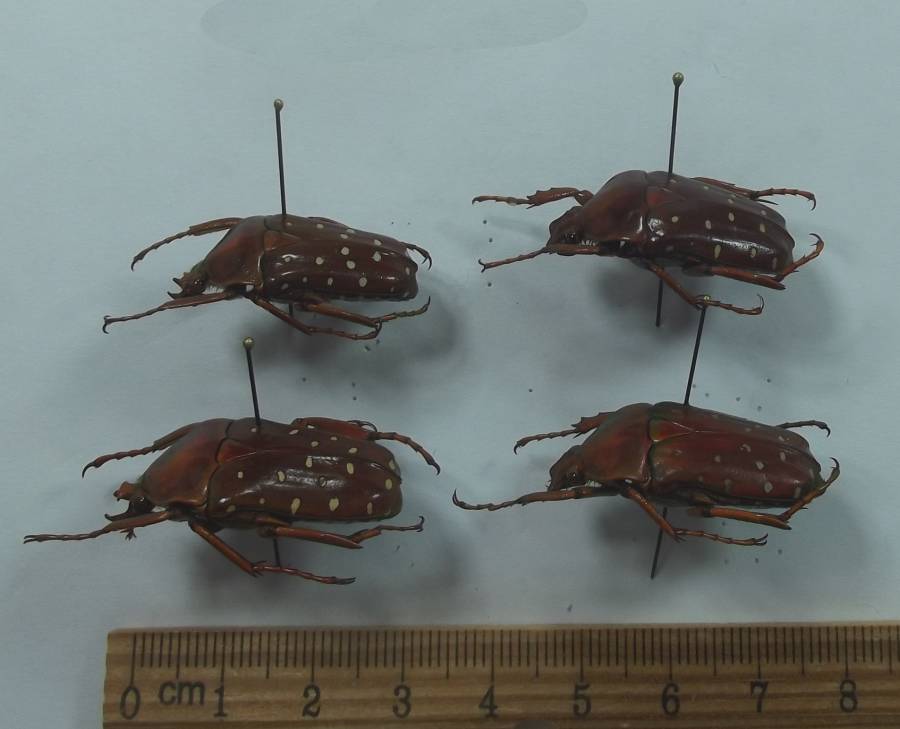SPECIES INFO
We received many of these brownish specimens from Cameroon. We attempted to degrease them several different ways, but were forced to admit that they were naturally brown in contrast to the normal green form.The Stephanorrhina genus of beetles appears confined to Africa. There are 10 species and two subspecies recognized by Kaoru Sakai in his excellent coverage of the Flower Beetles which was published in 1996 by the Endless Science Information. These small-medium sized beetles can be partially recognized by their numerous white spots on the elytra. Several species have brown elytra and several species have greenish elytra.
Males of several species have armature on their heads while others appear to lack any distinctive armature. One important characteristic that can help sort and identify different species is to observe that males lack spines on their tibias, while females usually have at least one outward facing spine. (Some males in some species look like females.) Also, it is interesting to note that in eastern Africa the species tend to have brownish elytra, while in western Africa the species have greenish elytra.
Beetles (Order Coleoptera) are a diverse group of insects found throughout the world. They usually can fly and typically have four wings. Two of the wings are hardened (elytra) and serve as a body cover to protect the flying wings and abdomen. Beetles begin their life as a larvae or grub that goes through a metamorphosis that turns this worm-like creature into an adult with six legs and four wings. There probably are over 500,000 species of beetles in the world. However, that number is only conjecture as the United States does not have a complete list of its known species.
The United States has relatively few exotic beetles. However, countries like Brazil, Mexico, Ghana, Zaire, Malaysia, and Peru have many beautiful beetles.
Exotic beetles are such a fascination in Europe and Japan that they are collected much as coins are collected throughout the rest of the world.
Insects (Class Insecta) are the most successful animals on Earth if success is measured by the number of species or the total number of living organisms. This class contains more than a million species, of which North America has approximately 100,000. (Recent estimates place the number of worldwide species at four to six million.)
Insects have an exoskeleton. The body is divided into three parts. The foremost part, the head, usually bears two antennae. The middle part, the thorax, has six legs and usually four wings. The last part, the abdomen, is used for breathing and reproduction.
Although different taxonomists divide the insects differently, about thirty-five different orders are included in most of the systems.
The following abbreviated list identifies some common orders of the many different orders of insects discussed herein:
Odonata: - Dragon and Damsel Flies
Orthoptera: - Grasshoppers and Mantids
Homoptera: - Cicadas and Misc. Hoppers
Diptera: - Flies and Mosquitoes
Hymenoptera: - Ants, Wasps, and Bees
Lepidoptera: - Butterflies and Moths
Coleoptera: - Beetles
Jointed Legged Animals (Phylum Arthropoda) make up the largest phylum. There are probably more than one million different species of arthropods known to science. It is also the most successful animal phylum in terms of the total number of living organisms.
Butterflies, beetles, grasshoppers, various insects, spiders, and crabs are well-known arthropods.
The phylum is usually broken into the following five main classes:
Arachnida: - Spiders and Scorpions
Crustacea: - Crabs and Crayfish
Chilopoda: - Centipedes
Diplopoda: - Millipedes
Insecta: - Insects
There are several other "rare" classes in the arthropods that should be mentioned. A more formal list is as follows:
Sub Phylum Chelicerata
C. Arachnida: - Spiders and scorpions
C. Pycnogonida: - Sea spiders (500 species)
C. Merostomata: - Mostly fossil species
Sub Phylum Mandibulata
C. Crustacea: - Crabs and crayfish
Myriapod Group
C. Chilopoda: - Centipedes
C. Diplopoda: - Millipedes
C. Pauropoda: - Tiny millipede-like
C. Symphyla: - Garden centipedes
Insect Group
C. Insecta: - Insects
The above list does not include some extinct classes of Arthropods such as the Trilobites.
Animal Kingdom contains numerous organisms that feed on other animals or plants. Included in the animal kingdom are the lower marine invertebrates such as sponges and corals, the jointed legged animals such as insects and spiders, and the backboned animals such as fish, amphibians, reptiles, birds, and mammals.


